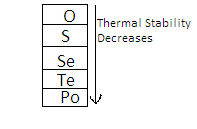
Which is the correct thermal stability order of $ {{\text{H}}_2}{\text{E}}\left( {{\text{E = O,S,Se,Te}}{\text{ and Po }}} \right) $ ?
A) $ {{\text{H}}_2}{\text{S < }}{{\text{H}}_2}{\text{O}} < {{\text{H}}_2}{\text{Se < }}{{\text{H}}_2}{\text{Te < }}{{\text{H}}_2}{\text{Po}} $
B) $ {{\text{H}}_2}{\text{O}} < {{\text{H}}_2}{\text{S}} < {{\text{H}}_2}{\text{Se < }}{{\text{H}}_2}{\text{Te < }}{{\text{H}}_2}{\text{Po}} $
C) $ {{\text{H}}_2}{\text{Po < }}{{\text{H}}_2}{\text{Te}} < {{\text{H}}_2}{\text{Se < }}{{\text{H}}_2}{\text{S < }}{{\text{H}}_2}{\text{O}} $
D) $ {{\text{H}}_2}{\text{Se < }}{{\text{H}}_2}{\text{Te}} < {{\text{H}}_2}{\text{Po < }}{{\text{H}}_2}{\text{O < }}{{\text{H}}_2}{\text{S}} $
Answer
525.9k+ views
Hint :All the elements are of Oxygen family .On going down the group, the thermal stability of $ {{\text{H}}_2}{\text{E}} $ decreases as the $ {\text{M - H}} $ bond energy decreases where M represents metals. So, $ {{\text{H}}_2}{\text{O}} $ will be the most thermally stable molecule.
Complete Step By Step Answer:
$ {\text{O,S,Se,Te,Po}} $ are the members of the oxygen family.

On going down the group, the thermal stability of $ {{\text{H}}_2}{\text{E}} $ decreases where E represents members of the oxygen family. This is because the $ {\text{M - H}} $ bond energy decreases as the size of the central atom increases. On going down the group,
The size of the central atom increases (due to increase in number of electrons).
The electrons of the most outer shell are far distance from the nucleus so they can be easily given which decreases the thermal stability.
The $ {\text{M - H}} $ atoms when combining their orbitals overlap. Thus they form a lower energy state and become stable.
This means that the two atoms come so close they penetrate each other's orbital and a new hybridized orbital is formed which is stable.
So the greater the overlapping, the greater is the bond energy. $ {{\text{H}}_2}{\text{O}} $ has greater overlapping than the other $ {{\text{H}}_2}{\text{E}} $ .
So the order is $ {{\text{H}}_2}{\text{Po < }}{{\text{H}}_2}{\text{Te}} < {{\text{H}}_2}{\text{Se < }}{{\text{H}}_2}{\text{S < }}{{\text{H}}_2}{\text{O}} $ .
Hence the correct answer is ‘C’.
Note :
The $ {\text{M - H}} $ bond energy is the energy required to break the bond formed between the M and H atom. This energy is affected by the following-
1. Atomic radius- with the increase in atomic radius, the bond energy between M and H decreases.
2. Nuclear charge-as the nuclear charge between the nucleus and the outer shell decreases, the bond energy also decreases.
Complete Step By Step Answer:
$ {\text{O,S,Se,Te,Po}} $ are the members of the oxygen family.

On going down the group, the thermal stability of $ {{\text{H}}_2}{\text{E}} $ decreases where E represents members of the oxygen family. This is because the $ {\text{M - H}} $ bond energy decreases as the size of the central atom increases. On going down the group,
The size of the central atom increases (due to increase in number of electrons).
The electrons of the most outer shell are far distance from the nucleus so they can be easily given which decreases the thermal stability.
The $ {\text{M - H}} $ atoms when combining their orbitals overlap. Thus they form a lower energy state and become stable.
This means that the two atoms come so close they penetrate each other's orbital and a new hybridized orbital is formed which is stable.
So the greater the overlapping, the greater is the bond energy. $ {{\text{H}}_2}{\text{O}} $ has greater overlapping than the other $ {{\text{H}}_2}{\text{E}} $ .
So the order is $ {{\text{H}}_2}{\text{Po < }}{{\text{H}}_2}{\text{Te}} < {{\text{H}}_2}{\text{Se < }}{{\text{H}}_2}{\text{S < }}{{\text{H}}_2}{\text{O}} $ .
Hence the correct answer is ‘C’.
Note :
The $ {\text{M - H}} $ bond energy is the energy required to break the bond formed between the M and H atom. This energy is affected by the following-
1. Atomic radius- with the increase in atomic radius, the bond energy between M and H decreases.
2. Nuclear charge-as the nuclear charge between the nucleus and the outer shell decreases, the bond energy also decreases.
Recently Updated Pages
Why are manures considered better than fertilizers class 11 biology CBSE

Find the coordinates of the midpoint of the line segment class 11 maths CBSE

Distinguish between static friction limiting friction class 11 physics CBSE

The Chairman of the constituent Assembly was A Jawaharlal class 11 social science CBSE

The first National Commission on Labour NCL submitted class 11 social science CBSE

Number of all subshell of n + l 7 is A 4 B 5 C 6 D class 11 chemistry CBSE

Trending doubts
1 Quintal is equal to a 110 kg b 10 kg c 100kg d 1000 class 11 physics CBSE

Why is steel more elastic than rubber class 11 physics CBSE

What is boron A Nonmetal B Metal C Metalloid D All class 11 chemistry CBSE

Bond order ofO2 O2+ O2 and O22 is in order A O2 langle class 11 chemistry CBSE

Discuss the various forms of bacteria class 11 biology CBSE

What is the difference between biodegradable and nonbiodegradable class 11 biology CBSE




